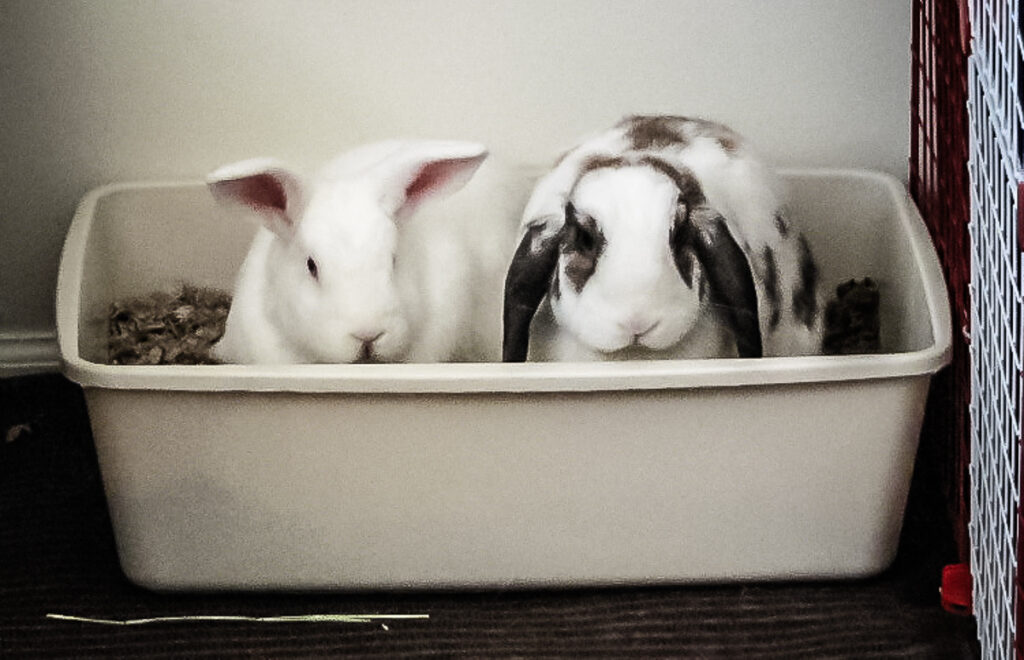The road to the local refuse disposal site is lined with auto wrecking yards and a rifle range. Convoys of amateur garbage men pay by the pound to use this hi-tech dump every weekend.
As a highly structured purge area, it’s an odd blend of ritual and chaos–a hubbub of hubcaps and wheels squeezing next to each other. With swing-out doors and tailgates pointed toward a concrete trench, the dust-masked men relieve their cargo beds of useful (or still useful) trashifacts.
In an almost rhythmic repetition of lifting and throwing, castaway objects are planted in this pit where nothing grows. Back and forth, great bulldozers seem to maim and mix the fresh offerings into homogenized piles–destination landfill.
Until six months ago the droppings from our roughly 80 rabbits went into this landfill every week. Where else?
Alternative Disposal
Miles away geographically and light years away philosophically is the home of Sandra and Bud Miles.
A ’50 Pontiac metal-woody sits outside a high wood fence flush with the sidewalk. We stepped inside, past the sturdy gate, where two easy-going dogs checked us out. (No problem.We smelled like rabbits). Next to a fine roomy doghouse is a vegetable garden. “Grass is nice, but it wastes valuable space–space that can be used for growing things,” advises Bud.
Vegetarians since 1983, they take what they eat–and how they grow it–very seriously. And growing starts with natural soil conditioning and fertilizer. That’s where rabbit manure comes in.
Although several knowledgeable organic gardeners had pointed out to us the value of rabbit manure (a rich combination of nitrogen, phosphorus, and potassium), Bud and Sandra were the first ones willing to drive over and pick it up a task which does us all a favor. They use some of the manure they get from us for their own vegetable garden. The rest they sell to various flower growers and donate the proceeds back to House Rabbit Society.
Inside the house, Marinell started interviewing Sandra while Bud and l moved some bags of rabbit manure from our wagon to his Model A pickup. “You can see l’m a big fan of yestertech,”
Bud said, as he glanced back at the vintage 4-banger. (The truck is no driveway icon. Everything inside the fence works.)
Deeper Soil
Although the rabbits whom they adopted from House Rabbit Society could easily have
been the whole story, the bigger story was well underway long before they became interested in house rabbits.
Bud learned about organic gardening and recycling before either term existed, while growing up on a subsistence farm in southern Michigan.
Sandra, even before she knew Bud, was interested in the concept of feeding products of the soil back to the soil as a key to completing the cycle. Her coffee grounds and tea bags always went to the potted plants. With a respect for living, growing things came a love for all creation–people and animals. “Once you love creatures of another species, you realize there’s no real difference except that they don’t speak our language.” It was Sandra’s idea to adopt a couple of neutered rabbits to commingle with their two cats, two dogs (former laboratory animals), and six pet chickens. “Sandra keeps my perspective in place,” said Bud “When the chickens eat the flowers or the rabbits eat the stereo cords, that’s when she reminds me of what’s most important. She brings back in me the awareness new as a child.”
Most of what’s eaten, in their shared environment, is by design. Food is not wasted. “What we don’t eat, the dogs will eat,” says Bud. “What the rabbits won’t eat, the chickens will eat.” The chickens furnish eggs, but it’s not the primary reason for keeping them. “Even if they never laid again, they would still be our pets. We enjoy watching them.”
The Mechanics of Recycling
In the Miles household recycling touches every commodity. Reuse of rabbit manure is part of the program. There is so little waste from the entire house and yard that it doesn’t even fill one trash barrel every two months. They don’t buy any canned goods but take reusable containers to buy bulk foods. In the winter, their papers are burned, and in the summer they’re shredded and worked into the soil.
We completed our tour by visiting the Miles backyard bakery. Next to the woodworking shop is a modern structure they built themselves, where fresh pastas of various kinds hang drying. Bud opened the brick oven door and reached in with a long-handled spatula. He smiled as he pulled out a loaf – one of many they furnished to various Berkeley area restaurants. Hand grown organic grains go into this bread and pasta dough.
Walking out with the end results (loaves of bread) in hand, we glanced at the compost piles were all begins again. Bulky material such as straw and paper is broken down with a shredder, converted from an on lawnmower.
When Bud first moved to California, he used his considerable mechanical abilities to reclaim and rework, automatic transmissions, finally marketed to drag racing enthusiasts as the B&M Stick-Hydro.
If you happened to be a California car-freak teenager in the late 50s Bud’s reworked shifter was on your must-buy list. Do recycle transmissions have anything to do with recycled nitrogen pellets?
Do rabbits re-ingest?
Another Sunday afternoon at the Resource Recovery Site. Was that the name of the dump before?
It’s less crowded today because there is a Raiders/bronco game on TV. More seagulls than dumpers are picking over the trash and the bright late son. Most of the usable rabbit droppings were picked up at HRS this morning by Bud Miles. Only the unreclaimed newspaper trailers – Full load every other week is Destin for disposal.
What’s this? Humans scavengers are pulling reclaimable items out of the mix? A wheelchair, a bowling ball. Maybe other people were reclaiming things before. Maybe I just hadn’t noticed.
©Copyright Bob Harriman. All Rights Reserved. Republished with the permission of the author.
Waste and Wisdom was originally published in House Rabbit Journal v1/n12, NOVEMBER/DECEMBER 1989
Bud and Ned take time out from the manure matters. A FAMILIAR FACE: Irene (on Sandra’s lap) cozys up to Ned

